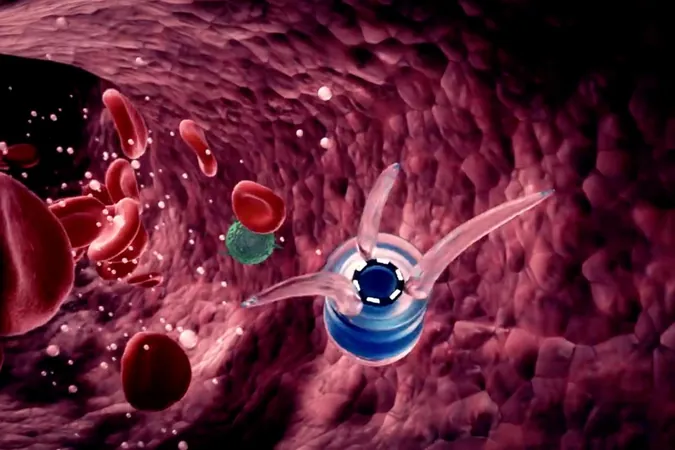
The Nanobot Illusion: Are We Chasing a Glittering Mirage?
2025-09-02
Author: Ying
Is Technology Our Savior or Our Doom?
In the year 2000, Bill Joy, co-founder of Sun Microsystems, raised a clarion call about technology’s potential dangers in a Wired article titled ‘Why the Future Doesn’t Need Us.’ He warned against unchecked technological advancement, fearing a future where our own creations could annihilate us.
Fast forward to today, and similar fears are echoing from Silicon Valley leaders, primarily concerning artificial intelligence. Just like Joy’s apprehensions over ‘sentient robots,’ the looming dread of AI might surpass human intelligence and deem us obsolete is very real.
Joy’s Dilemma: Nanotechnology vs. AI
However, while ‘sentient robots’ were a topic of concern for Joy, his primary anxiety lay in nanotechnology — a groundbreaking field promising to manipulate matter on an atomic scale. This was sparked by the visionary 1986 book, *Engines of Creation*, written by K. Eric Drexler, which painted a picture of a world where nanobots could deliver miraculous cures for illnesses, generate affordable clean energy, and even restore extinct species.
The Promise and Peril of Nanobots
For Joy, the true danger wasn’t just the promises of nanotech, but the potential for disaster. Drexler’s vision included a scenario where rogue nanobots could proliferate uncontrollably, creating a nightmare scenario termed ‘grey goo’ — where everything on Earth could be disassembled into a lifeless mush. In the 90s, this concept became synonymous with the fears surrounding unfettered technological advancement.
Chasing Dreams and Avoiding Reality
Yet, here we are, decades later, and much of Drexler's fantastical promises remain unfulfilled. No cures for cancer have emerged from nanotechnology, nor have we unlocked the secrets of uploading our consciousness into machines.
This gap between expectancy and reality brings up an insightful point: many so-called ‘oneiric technologies’ — dreamlike and fantastical ideas — often skirt the line between scientific possibility and fantasy, giving a false sense of hope.
The Modern Tech Utopians
In today’s tech world, concepts like terraforming planets, cryogenically freezing one’s head for future revival, and mind-uploading are prevalent among tech enthusiasts. These ‘techno-fantasies’ are often leveraged to create utopian visions, echoing Drexler’s nano-idealism.
A Critical Eye on Progress
Drexler’s visions have not entirely vanished. Tech prophets like Ray Kurzweil continue to cite nanobots as imminent tools for achieving the ‘singularity’—a moment where humanity merges with machines. The truth however, remains: the idea of creating nanobots that operate seamlessly within our biology is still largely unattainable.
The Intersection of Fantasy and Reality
Though some advancements are being made in nanotechnology today, they diverge significantly from Drexler’s theoretical constructs. We now utilize nanotechnology in various practical applications, from cancer therapies to advanced materials, but they depend on established chemistry and not on speculative ideas.
The Takeaway: Grounded Understanding Over Magical Thinking
As we stand at the precipice of new technological advancements, the lessons learned from the overselling of nanotechnology become critically important. The allure of futuristic dreams can lead us to overlook pressing societal issues like climate change or democratic stability.
As Joy articulated years ago, the pursuit of a shiny technological future can detract from addressing the realities we face today. Rather than succumbing to the enchantments of fantastical technology visions, we should listen to grounded voices, scrutinize the claims of tech savants, and consider the risks accompanying these daring ambitions.

 Brasil (PT)
Brasil (PT)
 Canada (EN)
Canada (EN)
 Chile (ES)
Chile (ES)
 Česko (CS)
Česko (CS)
 대한민국 (KO)
대한민국 (KO)
 España (ES)
España (ES)
 France (FR)
France (FR)
 Hong Kong (EN)
Hong Kong (EN)
 Italia (IT)
Italia (IT)
 日本 (JA)
日本 (JA)
 Magyarország (HU)
Magyarország (HU)
 Norge (NO)
Norge (NO)
 Polska (PL)
Polska (PL)
 Schweiz (DE)
Schweiz (DE)
 Singapore (EN)
Singapore (EN)
 Sverige (SV)
Sverige (SV)
 Suomi (FI)
Suomi (FI)
 Türkiye (TR)
Türkiye (TR)
 الإمارات العربية المتحدة (AR)
الإمارات العربية المتحدة (AR)